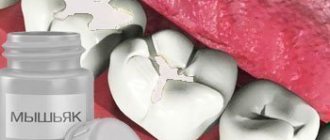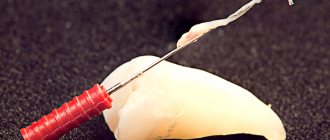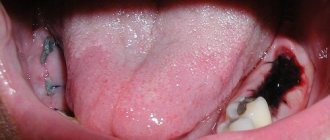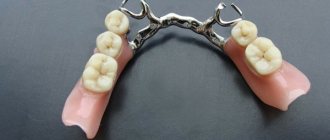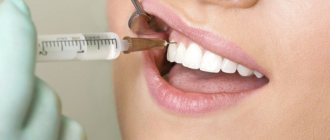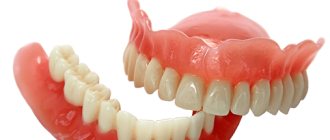Reasons why a dental bridge may fall off
The integrity of the dental bridge is influenced by the following factors:
- The bridge was made to inaccurate measurements. Dentists believe that a bridge can only be made for five crowns and no more, otherwise the bridge design becomes unreliable.
- If the neighboring teeth that support the bridge are poorly prepared for prosthetics, this can also cause the bridge to fly off.
- Crowns for supporting teeth must be made of high-quality material, and they must be fixed with high-quality dental cement.
- Improper oral and dental hygiene. To keep your artificial teeth clean, you should have your teeth professionally cleaned twice a year. If this is not done, the period of wearing dentures will be greatly reduced.
Tip #3: Visit the Emergency Room and Get an X-Ray
If a problem arises with a living tooth in which the crown has fallen off or broken off, then most people think first of all to visit the dentist. Although in reality, you first need to go to a place where you can get an X-ray of the gastrointestinal tract. In dentistry, you will not get examinations of those organs that are located below the head, but, for example, in the emergency room there are devices installed that will help you quickly take pictures of the desired area and study the situation. After the photographs have been taken, you can additionally consult a surgeon or gastroenterologist.
It is advisable to undergo an X-ray examination of the stomach
If crowns or elements of braces (the problem is also quite common) get into the gastrointestinal tract and small intestine, doctors resort to surgical intervention only in the most extreme cases. Basically, experts choose a wait-and-see approach, prescribing laxatives and enemas to remove foreign materials from the body, washing the stomach and intestines.
“Two years ago there was a situation where I swallowed a crown from a tooth, or rather not a complete crown, but a part of it that broke off. I immediately got scared and went to the doctor, they took an x-ray. The pictures showed where she was stuck, the doctor prescribed all sorts of pills. But nothing helped, it seemed to have grown into me. After a while, I began to notice tingling sensations on the right side and felt pain, so they scheduled surgery under anesthesia. It’s unpleasant, of course, that it all ended like this, but at least she remained alive. And I heard in the hospital that there can also be deaths from this, especially if the patient did not seek help in time...”
Karina, review from the dental portal gidpozubam.ru
What to do when a dental bridge has already fallen off?
The best way out of this situation is to see a dentist as soon as possible. When visiting a doctor, you must bring your saved prosthesis, even if it is cracked in half. You should not repair the bridge yourself using various adhesives that can damage healthy teeth.
If the bridge did not break when it fell out, it will be put back in place using dental cement. If the denture breaks, an impression of the patient's teeth will be taken and a dental technician will make a new denture, which will require additional costs and a long time.
How to remove crowns
The procedure for removing dental appliances is the responsibility of orthopedists and endodontists. Doctors have various techniques for removing dental structures at their disposal.
- Cutting the prosthesis using a bur
Traditional method of removing a single prosthesis. The artificial material is sawn and removed from the oral cavity. The procedure must be performed by a qualified and experienced physician. The method is suitable for dismantling budget or damaged models.
- Dismantling using ultrasound
Fast and safe removal method. Under the direct influence of ultrasonic waves on the composition, the binder material is destroyed. The product is removed undamaged. The method is suitable for models made of low-density materials.
- Manual crown remover
The work is performed using a special tool with metal hooks attached to the end. The dentist carefully hooks the edges of the dental device and removes it.
- Application of the Koch apparatus
Externally, the device looks like a crown remover. The product is equipped with a hook at the end and an activation button that provides mechanical action to destroy the cement. After the prosthesis becomes mobile, the doctor removes it with forceps.
- Coronaflex
The appearance of the device resembles a pistol. The device contains compressed air, which, after activation, flows out under high pressure. Under the influence of an air jet, the cement base of the crown is destroyed. The prosthesis and mucous membrane are not damaged.
This method applies to modern and expensive dental procedures. The method is suitable for removing expensive prosthetic models.
Installation of metal-ceramic dental bridges
Stage 1 - consultation.
During the first visit to the doctor, anamnesis is collected and the rehabilitation method is agreed upon.
Stage 2 - rehabilitation.
Preparation of the oral cavity, treatment of concomitant dental diseases, if any.
Stage 3 - production of the prosthesis.
Computer modeling is considered the most advanced and most accurate method for manufacturing orthopedic structures. In the case of metal ceramics, a metal frame is first made, and after applying the ceramics, the product is fired.
Stage 4 - implantation.
If the product is fixed on implants, a surgical stage is necessary. A classic denture requires grinding of adjacent teeth.
Stage 5 - installation.
Fitting and installation of the finished structure.
What to do
Since the entry of a sharp arc element into the digestive tract can be dangerous, you should not delay your visit to the doctor. Sometimes the incident goes away without complications, but there are cases when the arc causes severe spasms, vomiting, pain, impaired swallowing function, etc.
If you start eating in order to quickly remove the arch from the esophagus, it may end up in the stomach. In this case, diagnosis will be much more difficult. If the part is too large, paresis, damage to the trachea or bronchi, larynx may occur, and periesophagitis or mediastinitis may also develop. Timely consultation with a specialist will allow you to avoid complex operations and maintain the health of your internal organs.
A more serious situation is the inhalation of part of the arc, because in this case it may end up inside the lungs. Removing it will only be possible with the help of a bronchoscope. The faster this is done, the greater the chances of successful treatment without consequences.
Stock
-25%
Removable denture for 1 jaw 40,000 rub.
30,000 rub.
get -30 %
Dental implantation RUB 35,000.
50000 rub. 35,000 rub.
get -9 %
BASAL COMPLEX - Restoration of teeth on 1 jaw in 3 days 330,000 rub.
300,000 rub.
get -13 %
Metal-free dental crown made of zirconium dioxide 40,000 rub.
35,000 rub. get
Causes of crown loss
In modern dentistry, high-quality materials are used for dental prosthetics, but we should not forget that the crown remains not a natural tooth, but a special design. It consists of the body itself, simulating a tooth, a pin for fastening, and a cementing material.
The latter must be of high quality , applied in accordance with technology and in sufficient quantity. If at least one of these conditions is not met, instead of the 5-10 years guaranteed by the doctor, the crown will last no more than a year.
Dental crown
The success of the procedure largely depends on how accurately and correctly the doctor performed the preparatory procedures:
It takes several days for high-quality installation of a microprosthesis. During this period, the doctor must conduct an X-ray examination, install a pin, send a sketch of the future crown for modeling, and perform a fitting. Negligent attitude towards any of these stages or haste leads to premature loss of the microprosthesis.
Also, the reasons for the loss of an installed crown include:
- natural aging of the prosthesis after several years;
- mechanical damage, such as trauma from chewing hard food;
- abrasion of the crown base material;
- development of carious process under the structure.
What will the doctor do?
If the dental bridge is loose but not damaged, the dentist:
- Remove the prosthesis;
- If necessary, perform dental treatment;
- Reinstall the structure, securing it with fresh cement.
If the denture breaks, the dentist will install a new one.
To make the right decision, you need to know the exact reason. To do this you will need:
- Carry out a detailed inspection;
- Find out how long the structure will be used;
- What sensations does the patient experience?
- Take an x-ray of the supporting teeth.
If a child swallows a tooth
In the period from 6 to 11 years, active replacement of primary teeth with molars occurs. They fall out painlessly, so a situation often arises when a baby eats a molar while swallowing food. Parents should not panic: they do not have sharp edges or roots.
A hearty lunch - as a solution to the problem of a swallowed prosthesis
To ensure tooth extraction naturally, doctors recommend feeding your baby foods that stimulate the intestines. If your child has swallowed an incisor, make him oatmeal with some pieces of prunes added. Beet salad, fermented milk products and sweet yogurt improve and speed up the process.
Prevention helps to prevent tooth swallowing. When brushing every day, you should inspect your mouth to look for chips or cracks. Every 6 months you should visit a dentist who checks the condition of the crown and prosthesis, the quality of cement or clasps.
Video - what happens if you swallow a tooth or denture
Damage diagnostics
To find out the extent of damage and decide whether the structure needs to be removed, a tomography is done. Based on the results of the study, the dentist can assess the patient’s condition and move on to the next stage.
As a rule, when there is unsteadiness, removal of the prosthesis is practiced. No strengthening measures may be used. You cannot remove the bridge structure yourself. Only a doctor can do this without damaging the supporting teeth.
The most widely used modern method of denture removal is the use of a scaler. This is an ultrasonic installation that ensures the destruction of the bonding cement. The removal process goes smoothly. The design can be reused.
The practice of removing a bridge is simple and well established:
- The cement on which the support crowns are installed is crushed using ultrasonic or pneumatic installations;
- The denture is lifted with special tools and removed from the mouth.
There is no discomfort or pain. Healthy teeth are not damaged. In the future, you can install a new prosthesis on them.
A Kopp apparatus can also be used to remove the prosthesis. With its help, the prosthesis is snapped out. This option is used if the tooth under the denture hurts. The procedure is quite long and is performed under anesthesia. As a rule, after removing the bridge, it is possible to treat the tooth and then cover it with a new crown.
In what cases should you not install a bridge?
To avoid questions about why a dental bridge is loose and what to do if it becomes mobile, you need to know about the contraindications specifically for this type of prosthesis. It is clear that if there are no outer teeth in a row or there are no more than 4 teeth in a row, then it will not be possible to install a bridge. But there are also hidden or unknown to the patient pathologies - contraindications. They can only be detected with careful preparation for treatment - we add that this is the responsibility of the dentist. But some specialists neglect diagnosis, and as a result the patient suffers.
Conditions when bridge prosthetics on natural supporting teeth are prohibited are as follows:
- atrophy or “subsidence” of the bone in the area of support: atrophy will continue further, while the gums will begin to recede, and the tooth necks and roots will be exposed. Therefore, there is a risk of inflammation or caries; the supports themselves may begin to wobble, because lose fixation in the bone,
- inflammation and bleeding of gums,
- late stages of periodontitis and periodontal disease (these pathologies are easily diagnosed): a whole range of problems is observed here - bone atrophy, inflammation and decrease in the level of gums, tooth mobility,
- “undetected” pulpitis or periodontitis in supporting units: the dentist did not remove the “dental nerve” - depulpation (although now doctors always try to do this before prosthetics),
- the presence of cysts and granulomas under the roots,
- cracks in the roots
- poor canal filling during previous treatment (and the doctor did not notice this),
- malocclusion,
- bruxism and increased tone of the masticatory muscles.
How long will it take for the prosthesis to come out naturally?
If the doctor, using an x-ray examination, has determined that the swallowed prosthesis does not pose a danger, the patient can only wait. and the foreign body should come out naturally. This time may vary depending on the characteristics of a particular organism, proper nutrition, and the presence of chronic diseases of the digestive system.
If after the specified period of time the crown has not come out, it is worth undergoing a repeat X-ray examination. This will ensure that the object is not stuck and is moving through the intestines.
Advantages and disadvantages
- Good functional performance.
- Aesthetics are above average.
- Low cost (except for prostheses on implants).
- Reliability and durability of the design (a classic prosthesis lasts an average of 7 - 8 years, with implant support - 15 or longer).
- The possibility of allergic reactions in the patient.
- Additional contraindications associated with the presence of metal in the prosthesis.
- Installation in the smile area is not recommended, since metal elements can shine through the ceramics; over the years, a noticeable blue line appears at the junction of the gum and the prosthesis.
What to do if you swallow a tooth crown
When a crown falls out, it is often swallowed, especially if the incident happened at night. No need to worry: the prosthesis is made from non-toxic materials, so poisoning will not occur. However, you still need to quickly seek medical help.
Promptly contact a specialist
Usually the crown falls out without a pin, but if it is also swallowed, complications are possible , because it is made of durable metal. It is difficult for the human body to digest such material. There is also a danger from a crown that has broken off under mechanical stress, that is, it has crumbled, forming sharp edges.
X-ray (survey) of the abdominal cavity
In any case, to refute or confirm this, you should immediately go to the doctor. If there is bleeding in the oral cavity, you should call an ambulance so that prompt assistance can be provided in case of damage to the digestive tract.
The doctor refers the patient for an x-ray examination . It allows you to identify the location of the swallowed crown and evaluate its shape: whether it has sharp edges and whether it poses a danger to human health. The doctor decides on the need for gastric lavage or gives an approximate time frame for the passage of a foreign body through the intestines naturally.
Gastric lavage
At the slightest suspicion of possible damage to the stomach or in case of obstruction of a foreign body, it is advised to perform lavage as soon as possible. For this, use a solution of furatsilin or another neutral agent. In rare cases, if the prosthesis reaches the intestines but does not come out, an enema with distilled water is used.
Esophagoscope
If the above methods do not help, resort to surgical removal of the crown using an esophagoscope . This flexible instrument is inserted under local anesthesia, the process is accompanied by tracheal intubation. Using video monitoring and special narrow forceps, the doctor first removes the crown, then the device itself.
After surgery, control contrast radiography is required. This procedure will allow you to identify signs of damage to the walls of the esophagus and prescribe treatment in a timely manner. So, for damage up to 0.5 cm in diameter, antibiotic therapy and rinsing are sufficient - the mucous membrane will recover within a few days.
